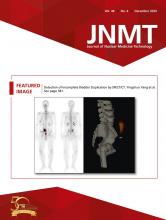It’s hard to believe that it’s time to write my December 2020 editorial marking the completion of my third year as JNMT Editor. I think the best thing I can say about this year is, “Wow, what a ride!”
Kathy S. Thomas, MHA, CNMT, PET, FSNMMI-TS
Thinking back to my editorial for the March issue of 2020, there was excitement in the air with the plans for the Technologist Section’s 50th Anniversary celebration; the completion of the much-anticipated 50th Anniversary historical supplement issue; and everyone looking forward to the many activities planned for the annual meeting in New Orleans.
Fast forward a few weeks into March, and the world as we all knew it changed. The COVID-19 pandemic required a rapid response at every level, and the health-care community as well as our first responders and those in essential job positions successfully rose to the challenge to provide the much-needed assistance to the world on a personal and professional level. Unfortunately, the world now sits in a holding pattern as it awaits the much-anticipated vaccine that promises to help the world return to better times. In the interim, JNMT continues to provide its readers with an opportunity to meet continuing education requirements, explore interesting scientific manuscripts and teaching cases, and stay current with activities in the nuclear medicine community.
In this issue, continuing education articles cover a variety of topics including a focused discussion on D-SPECT (1), an in-depth review of hepatobiliary imaging (2), and a discussion on lymphoscintigraphy for melanoma and breast cancer (3). The Practical Protocol Tip (4) supplements the lymphoscintigraphy manuscript and provides an imaging-specific protocol that can be added to a department’s procedure manual.
Professional behavior plays a critical role in the health-care environment. In the Educators’ Forum, McFarland et al. (5) discuss the need to teach professional development and what qualifies as a “professional” for those entering health care today. The manuscript emphasizes that, “teaching and evaluating professionalism, over and above technical training, is essential.”
Once again JNMT welcomes a student’s investigation (6). In this manuscript, radiation exposure readings from ring badges worn in different positions on the hand are investigated. This discussion, like so many created by nuclear medicine technology students during their training period, provides an excellent review of specific concepts and issues in nuclear medicine technology. JNMT, recognizing the value of these research studies, continues to encourage nuclear medicine technology students to submit their research projects for publication. Assistance is available if needed.
Also, don’t miss the many scientific manuscripts and teaching cases in this issue, including a discussion on the challenges of imaging dextrocardia (7); PET/MR versus PET/CT comparison in the primary staging of cervical cancer (8); and cholescintigraphy to differentiate true versus pseudo duodenal obstruction (9).
Additionally, don’t miss the book review on the 4th edition of Radiopharmaceuticals in Nuclear Pharmacy and Nuclear Medicine (10). The completely revised and updated edition is noted to be essential to any nuclear medicine or radiopharmacy practice and can serve as a key reference in preparation for specialty board examinations in nuclear medicine and nuclear pharmacy.
Finally, it’s important to keep in mind that the lasting success of JNMT relies on so many individuals—the continuous dedication and support from the SNMMI staff, the Associate and Consulting Editors, and the JNMT’s readers, authors, and reviewers. Thank you all for your commitment to JNMT. If you have ideas or suggestions for content, are considering submitting a manuscript, or would like to share your expertise by becoming a JNMT reviewer, please contact me at ksthomas0412{at}msn.com.
Although the holidays will most likely look a lot different this year—and yes, I know this will sound just like a greeting card—I would like to wish everyone a wonderful holiday season and a New Year that brings health and happiness to all.








